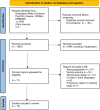Prevalence of mental health problems among children with long COVID: A systematic review and meta-analysis
- PMID: 37195978
- PMCID: PMC10191312
- DOI: 10.1371/journal.pone.0282538
Prevalence of mental health problems among children with long COVID: A systematic review and meta-analysis
Erratum in
-
Correction: Prevalence of mental health problems among children with long COVID: A systematic review and meta-analysis.PLoS One. 2023 Dec 14;18(12):e0296160. doi: 10.1371/journal.pone.0296160. eCollection 2023. PLoS One. 2023. PMID: 38096220 Free PMC article.
Abstract
Introduction: The number of children with mental health problems has more than doubled since the COVID-19 pandemic. However, the effect of long Covid on children's mental health is still debatable. Recognising long Covid as a risk factor for mental health problems in children will increase awareness and screening for mental health problems following COVID-19 infection, resulting in earlier intervention and lower morbidity. Therefore, this study aimed to determine the proportion of mental health problems post-COVID-19 infection in children and adolescents, and to compare them with the population with no previous COVID-19 infection.
Methodology: A systematic search was done in seven databases using pre-defined search terms. Cross-sectional, cohort and interventional studies reporting the proportion of mental health problems among children with long COVID in the English language from 2019 to May 2022 were included. Selection of papers, extraction of data and quality assessment were done independently by two reviewers. Studies with satisfactory quality were included in meta-analysis using R and Revman software programmes.
Results: The initial search retrieved 1848 studies. After screening, 13 studies were included in the quality assessments. Meta-analysis showed children who had previous COVID-19 infection had more than two times higher odds of having anxiety or depression, and 14% higher odds of having appetite problems, compared to children with no previous infection. The pooled prevalence of mental health problems among the population were as follows; anxiety: 9%(95% CI:1, 23), depression: 15%(95% CI:0.4, 47), concentration problems: 6%(95% CI: 3, 11), sleep problems: 9%(95% CI:5, 13), mood swings: 13% (95%CI:5, 23) and appetite loss: 5%(95% CI:1, 13). However, studies were heterogenous and lack data from low- and middle-income countries.
Conclusion: Anxiety, depression and appetite problems were significantly increased among post-COVID-19 infected children, compared to those without a previous infection, which may be attributed to long COVID. The findings underscore the importance of screening and early intervention of children post-COVID-19 infection at one month and between three to four months.
Copyright: © 2023 Hassan et al. This is an open access article distributed under the terms of the Creative Commons Attribution License, which permits unrestricted use, distribution, and reproduction in any medium, provided the original author and source are credited.
Conflict of interest statement
The authors have declared that no competing interests exist.
Figures















References
-
- WHO. WHO Coronavirus (COVID-19) Dashboard: World Health Organization; 2022 [updated 2022; cited 2022 September]. Available from: https://covid19.who.int/.
-
- WHO. WHO Director-General’s opening remarks at the media briefing on COVID-19–11 March 20202020. Available from: https://www.who.int/director-general/speeches/detail/who-director-genera....
Publication types
MeSH terms
LinkOut - more resources
Full Text Sources
Medical

